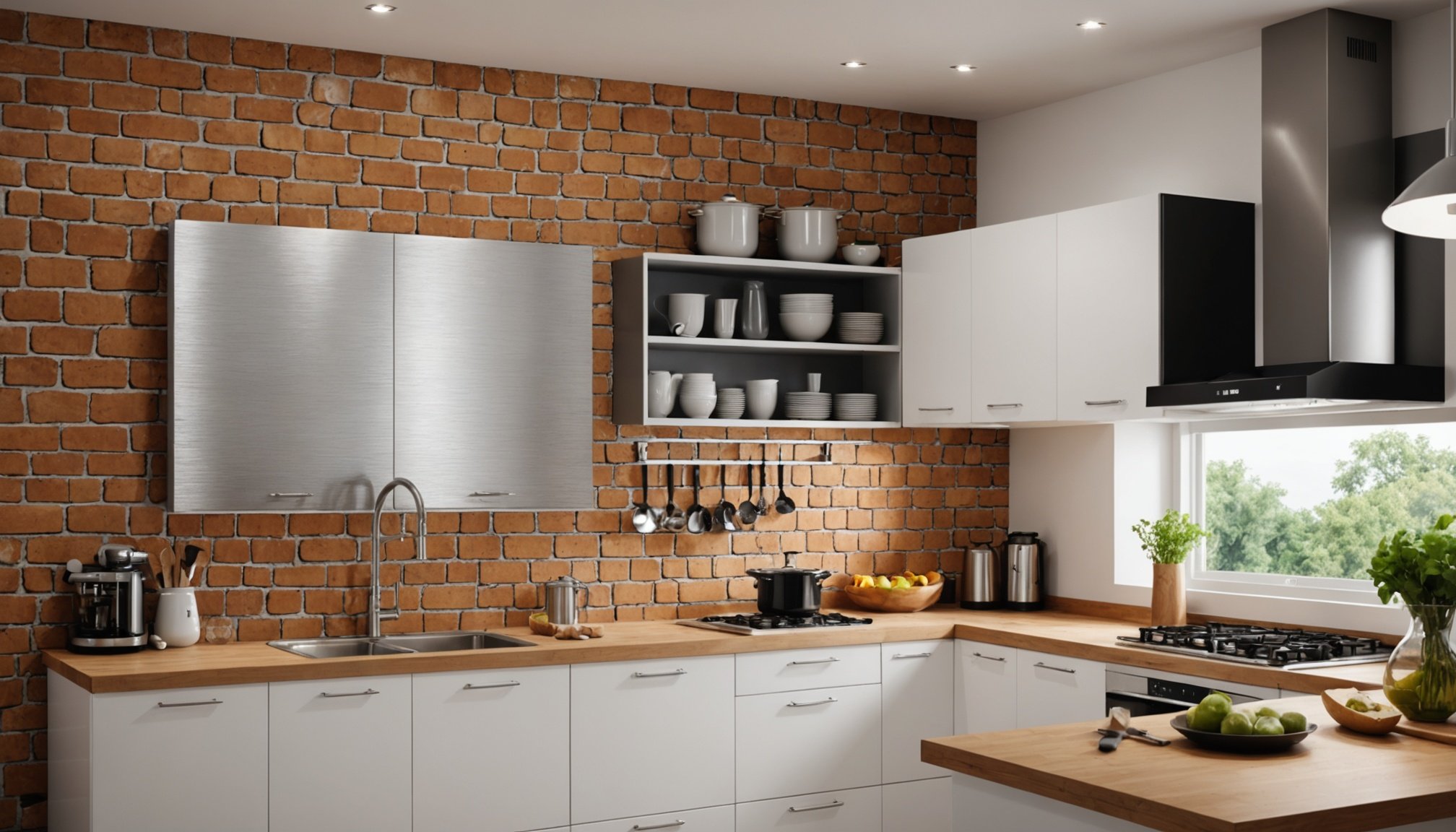Understanding Wall Insulation
Kitchen wall insulation plays a vital role in enhancing both energy efficiency and comfort levels. Properly installed insulation helps maintain desired temperatures, reducing the need for excessive heating or cooling. This not only leads to cost savings on energy bills but also contributes to a more stable kitchen environment.
When it comes to energy efficiency, kitchen wall insulation prevents unwanted heat exchange between the kitchen and its surrounding spaces. This efficiency is crucial, particularly in homes with open-plan designs, where maintaining a consistent indoor temperature can be challenging. By minimizing air leakage and thermal bridging, insulation keeps energy consumption in check.
Also to read : Transform Your Kitchen Experience: How Non-Stick Cookware Reduces Fat in Home Cooking
Insulation also improves comfort levels in the kitchen. With reduced drafts and more stable temperature control, the kitchen becomes a welcoming space to spend time in, regardless of the season. Home cooks will appreciate the more even temperatures, allowing for more consistent meal preparation and enjoyment.
The benefits of kitchen wall insulation extend beyond immediate comfort. It also enhances the home’s overall energy performance, leading to lower utility expenses and reducing the environmental impact. Investing in the right type and installation of kitchen wall insulation is a prudent decision, ensuring both improved comfort and energy efficiency for years to come.
Additional reading : Revamp Your Diet: How Clear Fridge Doors Encourage Healthier Eating at Home
Types of Insulation Materials
Selecting the right insulation materials for your kitchen walls is pivotal in achieving both energy efficiency and comfort. Here’s a closer look at some popular options:
Rigid Foam Insulation
Rigid foam is known for its robustness and excellent thermal resistance. It provides a high insulating value per inch, making it ideal for space-constrained areas like kitchens. Its moisture resistance adds durability, reducing the risk of mold. Although it might be costlier upfront compared to other materials, its longevity and efficiency make it a worthy investment.
Fiberglass Batts
Fiberglass batts are a common choice due to their affordability and effectiveness in thermal regulation. These materials fit snugly between studs, offering commendable heat retention. While installing, ensure batts are cut to size and fitted without compressing them for optimal performance.
Spray Foam Insulation
Spray foam stands out for its ability to expand and fill gaps, providing an airtight seal. It’s particularly advantageous in irregularly shaped areas. However, the application process can be complex, and it often requires professional installation. The cost, though higher, is offset by its superior energy-saving capabilities.
Installation Techniques
Embarking on insulation installation for kitchen walls can be done either as a DIY project or by hiring professional services, each having distinct advantages and considerations.
DIY Tips
For those opting for a DIY approach, selecting the right tools and materials is crucial. Precision in measuring and cutting insulation materials such as rigid foam or fiberglass batts guarantees a snug fit, enhancing both energy efficiency and comfort levels. However, some users find spray foam insulation challenging to apply on their own due to its tendency to over-expand, which can lead to materials wastage.
Professional Services
Hiring professionals ensures meticulous installation with minimal errors, especially for complex materials like spray foam, which requires specialized equipment and expertise. Professionals also provide recommendations on the most suitable insulation materials for specific kitchen setups, potentially improving the overall energy efficiency and comfort.
Common Mistakes
Regardless of the approach, common pitfalls include neglecting to seal gaps correctly or compressing materials, which can diminish insulation effectiveness. Taking time to learn or instruct professionals to avoid these mistakes can enhance the kitchen environment, leading to better temperature control, thereby boosting cooking efficiency.
Energy-Saving Benefits
Kitchen wall insulation offers substantial energy savings, making it a smart investment for homeowners. One of the primary benefits is the significant reduction in utility bills. By maintaining desired temperatures more efficiently, insulation minimizes the need for excessive heating or cooling. This not only leads to immediate savings but also contributes to the environment by reducing energy consumption.
The cost efficiency of proper insulation becomes even more apparent when analysing potential energy savings. Insulated walls prevent heat transfer, keeping the kitchen warmer in winter and cooler in summer. This reduces reliance on HVAC systems, resulting in lower energy costs. Moreover, the impact extends beyond obvious savings: it transforms the kitchen into a more pleasant space with little fluctuation in temperature.
Investing in kitchen wall insulation is regarded as a long-term investment. While the initial outlay may seem substantial, the cumulative savings over the years compensate for it. Homeowners find that their investment pays off through consistently lower energy bills and increased property worth. Encouraging homeowners to consider insulation is essential for financial and environmental benefits in the long run.
Enhancing Comfort Levels
Enhancing comfort improvements in your kitchen through proper insulation is essential for ensuring temperature control. A well-insulated kitchen maintains a stable environment, minimizing temperature fluctuations. This stability is especially beneficial during extreme weather conditions, as it helps keep the kitchen warm in winter and cool in summer.
Temperature control not only improves physical comfort but is also linked to kitchen ergonomics. For instance, a consistent indoor climate can enhance the overall cooking experience, making meal preparation more enjoyable. Chefs can focus on perfecting their recipes without battling uncomfortable temperatures.
Moreover, expert insights suggest that an optimal kitchen environment allows for better concentration, reducing stress and making cooking more efficient. Choosing the right insulation contributes significantly to achieving this. Well-installed insulation addresses common problem areas like drafts and cold spots. This ensures a comfortable and efficient working space, encouraging creativity and productivity during cooking sessions.
Incorporating effective insulation in the kitchen aligns with the need for both comfort improvements and temperature control. As a result, investing in proper wall insulation is a strategic decision designed to enhance the overall kitchen environment and transform cooking into a pleasant experience.
Impact on Cooking Efficiency
Kitchen wall insulation plays a crucial role in enhancing cooking efficiency. By effectively managing heat retention, wall insulation ensures that your kitchen maintains a stable temperature. This directly influences cooking times, with less energy required to keep ovens and stoves at desired temperatures. Thus, meal preparation becomes more predictable and efficient.
Effective insulation minimizes temperature fluctuations, enabling a smoother cooking process. Imagine preparing a meal without the annoyance of chilly drafts or sudden heat loss—your cooking experience becomes more pleasurable and consistent. Heat retention helps appliances work optimally, decreasing the frequency of reheating or overcooking, thereby conserving energy.
The ripple effect of better-insulated walls extends to meal preparation, where consistent indoor temperatures support steady cooking outcomes. Some homeowners even testify how a well-insulated kitchen has led to experimenting with new recipes, thanks to regulated cooking conditions. Witnessing these improvements, it’s clear why insulation is deemed an invaluable upgrade for kitchen enthusiasts focusing on both efficiency and the quality of their culinary creations.
Incorporating comprehensive kitchen wall insulation, therefore, not only meets energy efficiency goals but also elevates the entire cooking journey, emphasizing its practical significance.
Cost Considerations and ROI
Integrating kitchen insulation effectively involves understanding the cost analysis and assessing the return on investment (ROI). Homeowners should weigh upfront expenses against long-term benefits when deciding on insulation.
Upfront Costs
Initial investment for kitchen wall insulation varies depending on insulation types. Rigid foam and spray foam insulation, known for durability and energy performance, often have higher initial costs. For those seeking budget-friendly options, fiberglass batts offer an affordable choice with effective insulation advantages. A detailed break-even analysis, assessing cost savings through improved energy efficiency, helps in evaluating financial feasibility.
Long-term Savings
Realizing long-term savings is a key factor, as reduced energy bills contribute significantly to the return on investment. Homeowners experience reductions in utility expenses over time, offsetting initial costs. Insulating kitchens optimally ensures a moderate payback period, highlighting its value-enhancing potential. Elements like home size, climate conditions, and insulation material influence these payback durations.
Budgeting for Kitchen Insulation
Effective budgeting is essential. Homeowners are encouraged to plan expenditures carefully and consider materials with lasting benefits. Researching available financial assistance or rebates can aid in reducing initial costs. By aligning costs with long-term advantages, property owners can ensure financially sound kitchen insulation upgrades, boosting both comfort and efficiency.











